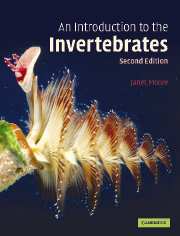Book contents
- Frontmatter
- Contents
- List of boxes
- Preface
- Acknowledgements
- Illustration acknowledgements
- Chapter 1 The process of evolution: natural selection
- Chapter 2 The pattern of evolution: methods of investigation
- Chapter 3 Porifera
- Chapter 4 Cnidaria
- Chapter 5 On being a worm
- Chapter 6 Platyhelminthes and Acoelomorpha
- Chapter 7 Nemertea
- Chapter 8 Nematoda
- Chapter 9 Annelida
- Chapter 10 Mollusca: general and Gastropoda
- Chapter 11 Mollusca: Bivalvia and Cephalopoda
- Chapter 12 Arthropoda: general
- Chapter 13 Crustacea
- Chapter 14 Chelicerata and Myriapoda
- Chapter 15 Insecta
- Chapter 16 Animals with lophophores
- Chapter 17 Echinodermata
- Chapter 18 Invertebrate Chordata and Hemichordata
- Chapter 19 Development
- Chapter 20 Invertebrate evolutionary history
- Further reading
- Glossary
- Index
Chapter 15 - Insecta
Published online by Cambridge University Press: 05 September 2012
- Frontmatter
- Contents
- List of boxes
- Preface
- Acknowledgements
- Illustration acknowledgements
- Chapter 1 The process of evolution: natural selection
- Chapter 2 The pattern of evolution: methods of investigation
- Chapter 3 Porifera
- Chapter 4 Cnidaria
- Chapter 5 On being a worm
- Chapter 6 Platyhelminthes and Acoelomorpha
- Chapter 7 Nemertea
- Chapter 8 Nematoda
- Chapter 9 Annelida
- Chapter 10 Mollusca: general and Gastropoda
- Chapter 11 Mollusca: Bivalvia and Cephalopoda
- Chapter 12 Arthropoda: general
- Chapter 13 Crustacea
- Chapter 14 Chelicerata and Myriapoda
- Chapter 15 Insecta
- Chapter 16 Animals with lophophores
- Chapter 17 Echinodermata
- Chapter 18 Invertebrate Chordata and Hemichordata
- Chapter 19 Development
- Chapter 20 Invertebrate evolutionary history
- Further reading
- Glossary
- Index
Summary
Most animals are insects and one group, the beetles, is the largest known order of animals. There are vast numbers of individuals, over a million described insect species and many times that number awaiting description. They are by all criteria outstandingly successful, primarily on land, where the close relationship between insects and flowering plants first evolved, but many species occur in fresh water, often as immature stages. Unlike crustaceans, there are few species in the sea. The following account first explains that insects owe their success as terrestrial arthropods to a number of special characteristics, such as their water conservation mechanisms (already introduced in the previous three chapters) and the power of flight, which is so important that it demands a relatively full discussion. The life cycle is introduced to show that it provides flexibility, especially in those insects where there is a pupa, a transitional form that may provide a resting stage additional to the egg. An indication of the range of insect orders is given, the evolution of social insects is briefly discussed and finally the contribution of the fruit fly Drosophila to our knowledge of genetics is explained.
- Type
- Chapter
- Information
- An Introduction to the Invertebrates , pp. 192 - 212Publisher: Cambridge University PressPrint publication year: 2006



